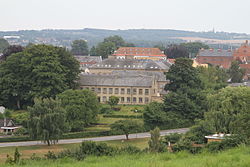Danmarks Forsorgsmuseum
 View of the Forsorgsmuseet |
|
| Data | |
|---|---|
| place | Svendborg |
| Art |
Social museum
|
| architect | Jens Juel Eckers |
| opening | 2002 |
| operator | |
| Website | |
Danmarks Forsorgsmuseum is part of the Svendborg Museum in the Danish city of Svendborg .
Name and location
The museum is located in the former Fattig- og Arbejdsanstalt ( German Poor and Labor Institution ). The building complex from 1872 was then put into operation as a state-of-the-art and future-oriented solution to help the city's poor. In 1933 the Fattig- og Arbejdsanstalt was renamed to Arbejdsanstalten Viebæltegaard and in 1961 to Forsorgshjemmet Viebæltegaard . In that year the barbed wire surrounding the site disappeared and the personal restrictions of the residents were made clear by the Forsorgsloven 1961 ( German supply law 1961) canceled. In 1974 the house was closed after the last residents moved to other nursing homes .
In order to save the building from demolition, the city took it over to set up a museum. This was opened in 2002. The buildings are under monument protection .
The Forsorgsmuseum is a social history museum that mainly shows the history of care and health care in Denmark. The various exhibitions show how the community has treated its very weakest, threatened by homelessness and social exclusion, children and adults alike.
They tell about the people on the dark side of life and about what the welfare state and private individuals have done to help them with this poor house .
history
In the Middle Ages, the monks in the monasteries and independent foundations were responsible for caring for the poor. In the 18th century the idea arose that government agencies should take over this task.
In 1834 Svendborg opened the first poor house on Bagergade. It was a small town house that poor people could work in in exchange for their food. Four years later a new poor house was opened in Fruestræde because the house in Bagergade had become too small.
The poor house in Fruestræde was significantly larger and had the same function as in Bagergade: working and eating. People worked on looms to make money selling their products. It turned out, however, that the original thought was unsuccessful: the poor went to their homes at the end of the day and spent their money on alcohol. There was no control.
Fattiggården
The architect Jens Juel Eckers drew up the plan of Fattiggården in 1871. Fattiggården was never officially called a poor house.
The key difference between the new and old poor houses was that the poor lived, worked and slept in them. So they were under constant supervision. Regular daily living should help them change their lifestyle.
Fattiggården was built to separate the poor from lazy beggars and transform them into good citizens. The poor were divided into two types: the “worthy” ( Danish værdige ) and the “unworthy” ( Danish uværdige ). Both groups had their own departments, separated by walls.
There was a high wall between the two buildings and there was a strict hierarchy within these walls. The worthy lived in the precautionary department and the unworthy in the labor institution.
The unworthy poor were able-bodied men and women who had no excuse for their self-inflicted poverty. The ordinances of 1872 say that the unworthy are "able-bodied but lazy and unwilling subjects " who should be led with a "firm hand". "Loose women, homeless people and beggars" also listened to the unworthy . The department was separated by sex. The windows were barred and the walls were barbed wire.
The worthy were the old and the sick, who could no longer take care of themselves. They were "right and worthy" and if they had good arguments for their poverty, they got better living conditions. They still had to work, but there were no window bars for them. Old couples could live together.
The dignified bedrooms were on the first floor and had windows overlooking the city. The corridor in her department ran along the courtyard windows. It was the other way around with the unworthy. From their bedroom they looked out into the courtyards.
A stay in the poorhouse was shameful for both groups, and each tried to avoid it. The place was supposed to be a deterrent, so the poor only came when they really needed public support.
With a stay in Fattiggården , the residents lost the right to marry whomever they wanted. They were not allowed to vote in the parliamentary elections and they were not allowed to own anything.
The re-education that the perpetrators should go through should be done through both work and the Christian faith. Therefore, Fattiggården had its own church that could handle this task. Next to the church there was a pigsty and a large vegetable garden. The Fattiggården should be as self-sufficient as possible, so that he did not mean a financial burden on the community.
museum
The Svendborg Museum has owned the buildings at Grubbemøllevej since 1974 . The Forsmorgsmuseet consists of two large buildings with an exhibition, church hall and chapel as well as three economic areas that are fenced in with barbed wire from historical times. Another building is used for the administration of the Svendborg Museum as well as for Svendborg Byhistoriske Arkiv ( Svendborg City History Archives) and Svendborg Søfartsarkiv ( Svendborg City Maritime Archives ).
Web links
Individual evidence
- ↑ Morten Mikkelsen: Fattiggården var sidste udvej. In: kristeligt-dagblad.dk. Kristeligt Dagblad, December 14, 2009, accessed March 2, 2018 (Danish).
- ↑ Fattiggården i Svendborg. In: museernepaakanten.dk. Retrieved March 2, 2018 (Danish).
- ↑ FRA PRESTIGE TIL SKAM - FATTIGGÅRDEN I 102 ÅR. In: museernepaakanten.dk. Retrieved March 2, 2018 (Danish).
- ^ Museum harbor. In: svendborgmuseum.dk. Retrieved March 2, 2018 (Danish).
- ↑ ARKITEKTUR OG FATTIGDOMSSYN. In: museernepaakanten.dk. Retrieved March 2, 2018 (Danish).
